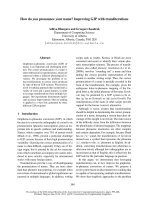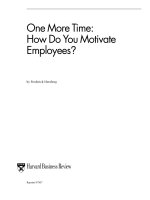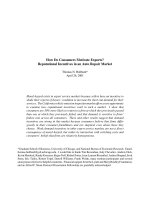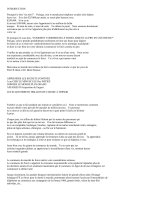ONE MORE TIME: HOW DO YOU MOTIVATE EMPLOYEES? doc
Bạn đang xem bản rút gọn của tài liệu. Xem và tải ngay bản đầy đủ của tài liệu tại đây (88.07 KB, 15 trang )
One More Time:
How Do You Motivate
Employees?
by Frederick Herzberg
Reprint 87507
Harvard Business Review
Harvard Business Review
Subscription Service
P.O. Box 52623
Boulder, CO 80322-2623
Telephone: U.S. and Canada (800) 274-3214
Outside U.S. 44-85-846-8888
Fax: (617) 496-8145
American Express, MasterCard, VISA accepted. Billing available.
Harvard Business Review
Operations Department
Soldiers Field
Boston, MA 02163
Telephone: (800) 545-7685
Fax: (617) 496-8145
Inquire about HBR’s custom service for quantity orders.
Imprint your company’s logo on reprint covers, select articles
for custom collections or books. Color available.
Telephone: (617) 495-6198
Fax: (617) 496-2470
For permission to quote or reprint on a one-time basis:
Telephone: (800) 545-7685
Fax: (617) 495-6985
For permission to re-publish please write or call:
Permissions Editor
Harvard Business School Publishing Corporation
Soldiers Field
Boston, MA 02163
(617) 495-6849
HBR Subscriptions
HBR Article Reprints
HBR Index
HBR Custom Reprints
Permissions
Harvard Business Review
SEPTEMBER-OCTOBER 1987
Reprint Number
Harvard Business Review
JOHN O. WHITNEY TURNAROUND MANAGEMENT EVERY DAY 87514
TED KOLDERIE EDUCATION THAT WORKS: 87508
THE RIGHT ROLE FOR BUSINESS
CHESTER E. FINN, JR. EDUCATION THAT WORKS: 87504
MAKE THE SCHOOLS COMPETE
SIR ADRIAN CADBURY ETHICAL MANAGERS MAKE THEIR OWN RULES 87502
ALAN M. WEBBER GERALD R. FORD: THE STATESMAN AS CEO 87505
JOHN DEARDEN MEASURING PROFIT CENTER MANAGERS 87503
WILLIAM J. BRUNS, JR., AND INFORMATION TECHNOLOGY PUTS POWER 87501
F. WARREN MCFARLAN IN CONTROL SYSTEMS
RICHARD J. SCHONBERGER FRUGAL MANUFACTURING 87512
B. SHAPIRO, V. RANGAN, MANAGE CUSTOMERS FOR PROFITS 87513
R. MORIARTY, AND E. ROSS
FREDERICK HERZBERG ONE MORE TIME: HOW DO YOU MOTIVATE EMPLOYEES? 87507
PROBING OPINIONS
COMPETITIVENESS SURVEY: HBR READERS RESPOND 87515
GROWING CONCERNS
KENNETH G. HARDY AND BUYING GROUPS: CLOUT FOR SMALL BUSINESSES 87506
ALLAN J. MAGRATH
KEEPING INFORMED
MARISA MANLEY PRODUCT LIABILITY: YOU’RE MORE EXPOSED 87509
THAN YOU THINK
FOR THE MANAGER’S BOOKSHELF
THOMAS P. ROHLEN WHY JAPANESE EDUCATION WORKS 87510
SPECIAL REPORT
COREY ROSEN AND HOW WELL IS EMPLOYEE OWNERSHIP WORKING? 87511
MICHAEL QUARREY
How many articles, books, speeches, and work-
shops have pleaded plaintively, “How do I get an
employee to do what I want?”
The psychology of motivation is tremendously
complex, and what has been unraveled with any
degree of assurance is small indeed. But the dismal
ratio of knowledge to speculation has not damp-
ened the enthusiasm for new forms of snake oil that
are constantly coming on the market, many of
them with academic testimonials. Doubtless this
article will have no depressing impact on the mar-
ket for snake oil, but since the ideas expressed in it
have been tested in many corporations and other or-
ganizations, it will help – I hope – to redress the im-
balance in the aforementioned ratio.
‘Motivating’ with KITA
In lectures to industry on the problem, I have
found that the audiences are anxious for quick and
practical answers, so I will begin with a straightfor-
ward, practical formula for moving people.
What is the simplest, surest, and most direct way
of getting someone to do something? Ask? But if
the person responds that he or she does not want to
do it, then that calls for psychological consultation
to determine the reason for such obstinacy. Tell the
person? The response shows that he or she does not
understand you, and now an expert in communica-
tion methods has to be brought in to show you how
to get through. Give the person a monetary incen-
tive? I do not need to remind the reader of the com-
plexity and difficulty involved in setting up and ad-
ministering an incentive system. Show the person?
This means a costly training program. We need a
simple way.
Every audience contains the “direct action” man-
ager who shouts, “Kick the person!” And this type
of manager is right. The surest and least circumlo-
cuted way of getting someone to do something is to
administer a kick in the pants – to give what might
be called the KITA.
There are various forms of KITA, and here are
some of them:
Negative physical KITA. This is a literal applica-
tion of the term and was frequently used in the
past. It has, however, three major drawbacks: (1) it
is inelegant; (2) it contradicts the precious image of
benevolence that most organizations cherish; and
(3) since it is a physical attack, it directly stimu-
lates the autonomic nervous system, and this often
HARVARD BUSINESS REVIEW September-October 1987 Copyright © 1987 by the President and Fellows of Harvard College. All rights reserved.
HBR CLASSIC
One More Time:
How Do You Motivate
Employees?
by Frederick Herzberg
To mark the 65th birthday of the Harvard Business Re-
view, it’s appropriate to republish as a “Classic” one of
its landmark articles. Frederick Herzberg’s contribution
has sold more than 1.2 million reprints since its publica-
tion in the January-February 1968 issue. By some
300,000 copies over the runner-up, that is the largest sale
of any of the thousands of articles that have ever ap-
peared between HBR’s covers. Frederick Herzberg, Dis-
tinguished Professor of Management at the University of
Utah, was head of the department of psychology at Case
Western Reserve University when he wrote this article.
His writings include the book Work and the Nature of
Man (World, 1966).
results in negative feedback – the employee may
just kick you in return. These factors give rise to
certain taboos against negative physical KITA.
In uncovering infinite sources of psychological
vulnerabilities and the appropriate methods to play
tunes on them, psychologists have come to the res-
cue of those who are no longer permitted to use
negative physical KITA. “He took my rug away”; “I
wonder what she meant by that”; “The boss is al-
ways going around me” – these symptomatic ex-
pressions of ego sores that have been rubbed raw are
the result of application of:
Negative psychological KITA. This has several
advantages over negative physical KITA. First, the
cruelty is not visible; the bleeding is internal and
comes much later. Second, since it affects the higher
cortical centers of the brain with its inhibitory pow-
ers, it reduces the possibility of physical backlash.
Third, since the number of psychological pains that
a person can feel is almost infinite, the direction and
site possibilities of the KITA are increased many
times. Fourth, the person administering the kick
can manage to be above it all and let the system ac-
complish the dirty work. Fifth, those who practice it
receive some ego satisfaction (one-upmanship),
whereas they would find drawing blood abhorrent.
Finally, if the employee does complain, he or she
can always be accused of being paranoid; there is no
tangible evidence of an actual attack.
Now, what does negative KITA accomplish? If I
kick you in the rear (physically or psychologically),
who is motivated? I am motivated; you move! Neg-
ative KITA does not lead to motivation, but to
movement. So:
Positive KITA. Let us consider motivation. If I
say to you, “Do this for me or the company, and in
return I will give you a reward, an incentive, more
status, a promotion, all the quid pro quos that exist
in the industrial organization,” am I motivating
you? The overwhelming opinion I receive from
management people is, “Yes, this is motivation.”
I have a year-old Schnauzer. When it was a small
puppy and I wanted it to move, I kicked it in the
rear and it moved. Now that I have finished its obe-
dience training, I hold up a dog biscuit when I want
the Schnauzer to move. In this instance, who is mo-
tivated – I or the dog? The dog wants the biscuit,
but it is I who want it to move. Again, I am the one
who is motivated, and the dog is the one who
moves. In this instance all I did was apply KITA
frontally; I exerted a pull instead of a push. When
industry wishes to use such positive KITAs, it has
available an incredible number and variety of dog
biscuits (jelly beans for humans) to wave in front of
employees to get them to jump.
Why is it that managerial audiences are quick to
see that negative KITA is not motivation, while
they are almost unanimous in their judgment that
positive KITA is motivation. It is because negative
KITA is rape, and positive KITA is seduction. But it
is infinitely worse to be seduced than to be raped;
the latter is an unfortunate occurrence, while the
former signifies that you were a party to your own
downfall. This is why positive KITA is so popular:
it is a tradition; it is the American way. The organi-
zation does not have to kick you; you kick yourself.
Myths About Motivation
Why is KITA not motivation? If I kick my dog
(from the front or the back), he will move. And when
I want him to move again, what must I do? I must
kick him again. Similarly, I can charge a person’s
battery, and then recharge it, and recharge it again.
But it is only when one has a generator of one’s own
that we can talk about motivation. One then needs
no outside stimulation. One wants to do it.
With this in mind, we can review some positive
KITA personnel practices that were developed as at-
tempts to instill “motivation”:
1. Reducing time spent at work. This represents
a marvelous way of motivating people to work –
getting them off the job! We have reduced (formally
and informally) the time spent on the job over the
last 50 or 60 years until we are finally on the way to
the “6
1
⁄2-day weekend.” An interesting variant of
this approach is the development of off-hour recre-
ation programs. The philosophy here seems to be
that those who play together, work together. The
fact is that motivated people seek more hours of
work, not fewer.
2. Spiraling wages. Have these motivated people?
Yes, to seek the next wage increase. Some me-
dievalists still can be heard to say that a good de-
pression will get employees moving. They feel that
if rising wages don’t or won’t do the job, reducing
them will.
3. Fringe benefits. Industry has outdone the most
welfare-minded of welfare states in dispensing
cradle-to-the-grave succor. One company I know of
had an informal “fringe benefit of the month club”
going for a while. The cost of fringe benefits in this
country has reached approximately 25% of the
wage dollar, and we still cry for motivation.
People spend less time working for more money
and more security than ever before, and the trend
cannot be reversed. These benefits are no longer re-
wards; they are rights. A 6-day week is inhuman, a
10-hour day is exploitation, extended medical cov-
erage is a basic decency, and stock options are the
MOTIVATING EMPLOYEES
6
HARVARD BUSINESS REVIEW September-October 1987
salvation of American initiative. Unless the ante
is continuously raised, the psychological reaction
of employees is that the company is turning back
the clock.
When industry began to realize that both the eco-
nomic nerve and the lazy nerve of their employees
had insatiable appetites, it started to listen to the
behavioral scientists who, more out of a humanist
tradition than from scientific study, criticized man-
agement for not knowing how to deal with people.
The next KITA easily followed.
4. Human relations training. Over 30 years of
teaching and, in many instances, of practicing psy-
chological approaches to handling people have re-
sulted in costly human relations programs and, in
the end, the same question: How do you motivate
workers? Here, too, escalations have taken place.
Thirty years ago it was necessary to request,
“Please don’t spit on the floor.” Today the same ad-
monition requires three “pleases” before the em-
ployee feels that a superior has demonstrated the
psychologically proper attitude.
The failure of human relations training to produce
motivation led to the conclusion that supervisors or
managers themselves were not psychologically true
to themselves in their practice of interpersonal de-
cency. So an advanced form of human relations
KITA, sensitivity training, was unfolded.
5. Sensitivity training. Do you really, really un-
derstand yourself? Do you really, really, really trust
other people? Do you really, really, really, really co-
operate? The failure of sensitivity training is now
being explained, by those who have become oppor-
tunistic exploiters of the technique, as a failure to
really (five times) conduct proper sensitivity train-
ing courses.
With the realization that there are only temporary
gains from comfort and economic and interpersonal
KITA, personnel managers concluded that the fault
lay not in what they were doing, but in the employ-
ee’s failure to appreciate what they were doing. This
opened up the field of communications, a whole
new area of “scientifically” sanctioned KITA.
6. Communications. The professor of communi-
cations was invited to join the faculty of manage-
ment training programs and help in making em-
ployees understand what management was doing
for them. House organs, briefing sessions, supervi-
sory instruction on the importance of communica-
tion, and all sorts of propaganda have proliferated
until today there is even an International Council
of Industrial Editors. But no motivation resulted,
and the obvious thought occurred that perhaps
management was not hearing what the employees
were saying. That led to the next KITA.
7. Two-way communication. Management or-
dered morale surveys, suggestion plans, and group
participation programs. Then both employees and
management were communicating and listening to
each other more than ever, but without much im-
provement in motivation.
The behavioral scientists began to take another
look at their conceptions and their data, and they
took human relations one step further. A glimmer of
truth was beginning to show through in the writings
of the so-called higher-order-need psychologists.
People, so they said, want to actualize themselves.
Unfortunately, the “actualizing” psychologists got
mixed up with the human relations psychologists,
and a new KITA emerged.
8. Job participation. Though it may not have been
the theoretical intention, job participation often be-
came a “give them the big picture” approach. For
example, if a man is tightening 10,000 nuts a day on
an assembly line with a torque wrench, tell him he
is building a Chevrolet. Another approach had the
goal of giving employees a “feeling” that they are
determining, in some measure, what they do on the
job. The goal was to provide a sense of achievement
rather than a substantive achievement in the task.
Real achievement, of course, requires a task that
makes it possible.
But still there was no motivation. This led to the
inevitable conclusion that the employees must be
sick, and therefore to the next KITA.
9. Employee counseling. The initial use of this
form of KITA in a systematic fashion can be credited
to the Hawthorne experiment of the Western Elec-
tric Company during the early 1930s. At that time,
it was found that the employees harbored irrational
feelings that were interfering with the rational oper-
ation of the factory. Counseling in this instance was
a means of letting the employees unburden them-
selves by talking to someone about their problems.
Although the counseling techniques were primi-
tive, the program was large indeed.
The counseling approach suffered as a result of
experiences during World War II, when the pro-
grams themselves were found to be interfering
with the operation of the organizations; the coun-
selors had forgotten their role of benevolent listen-
ers and were attempting to do something about the
problems that they heard about. Psychological
counseling, however, has managed to survive the
negative impact of World War II experiences and
today is beginning to flourish with renewed so-
phistication. But, alas, many of these programs,
like all the others, do not seem to have lessened the
pressure of demands to find out how to motivate
workers.
HARVARD BUSINESS REVIEW September-October 1987
7
Since KITA results only in short-term move-
ment, it is safe to predict that the cost of these pro-
grams will increase steadily and new varieties will
be developed as old positive KITAs reach their sati-
ation points.
Hygiene vs. Motivators
Let me rephrase the perennial question this way:
How do you install a generator in an employee? A
brief review of my motivation-hygiene theory of job
attitudes is required before theoretical and practical
suggestions can be offered. The theory was first
drawn from an examination of events in the lives of
engineers and accountants. At least 16 other inves-
tigations, using a wide variety of populations (in-
cluding some in the Communist countries), have
since been completed, making the original research
one of the most replicated studies in the field of job
attitudes.
The findings of these studies, along with corrobo-
ration from many other investigations using differ-
8
HARVARD BUSINESS REVIEW September-October 1987
Exhibit I Factors affecting job attitudes as
reported in 12 investigations
Factors characterizing 1,844 events
on the job that led
to extreme dissatisfaction
Percentage
frequency
All factors
contributing to
job dissatisfaction
Ratio and percent
All factors
contributing to
job satisfaction
Factors characterizing 1,753 events
on the job that led
to extreme satisfaction
50% 40 30 20 10 0 10 20 30 50%40
Achieve-
ment
Recognition
Work itself
Responsibility
Advancement
Growth
Company policy
and administration
Supervision
Relationship with supervisor
Work conditions
Salary
Relationship with peers
Status
Security
80%
31
69 Hygiene
Motivators
19
81
60 40 20 0 20 40 60 80%
Personal life
Relationship with subordinates
ent procedures, suggest that the factors involved in
producing job satisfaction (and motivation) are sep-
arate and distinct from the factors that lead to job
dissatisfaction. Since separate factors need to be
considered, depending on whether job satisfaction
or job dissatisfaction is being examined, it follows
that these two feelings are not opposites of each
other. The opposite of job satisfaction is not job dis-
satisfaction but, rather, no job satisfaction; and
similarly, the opposite of job dissatisfaction is not
job satisfaction, but no job dissatisfaction.
Stating the concept presents a problem in seman-
tics, for we normally think of satisfaction and dis-
satisfaction as opposites – i.e., what is not satisfy-
ing must be dissatisfying, and vice versa. But when
it comes to understanding the behavior of people in
their jobs, more than a play on words is involved.
Two different needs of human beings are involved
here. One set of needs can be thought of as stemming
from humankind’s animal nature – the built-in drive
to avoid pain from the environment, plus all the
learned drives that become conditioned to the basic
biological needs. For example, hunger, a basic biolog-
ical drive, makes it necessary to earn money, and
then money becomes a specific drive. The other set
of needs relates to that unique human characteristic,
the ability to achieve and, through achievement, to
experience psychological growth. The stimuli for the
growth needs are tasks that induce growth; in the in-
dustrial setting, they are the job content. Contrari-
wise, the stimuli inducing pain-avoidance behavior
are found in the job environment.
The growth or motivator factors that are intrin-
sic to the job are: achievement, recognition for
achievement, the work itself, responsibility, and
growth or advancement. The dissatisfaction-avoid-
ance or hygiene (KITA) factors that are extrinsic to
the job include: company policy and administra-
tion, supervision, interpersonal relationships,
working conditions, salary, status, and security.
A composite of the factors that are involved in
causing job satisfaction and job dissatisfaction,
drawn from samples of 1,685 employees, is shown
in Exhibit I. The results indicate that motivators
were the primary cause of satisfaction, and hygiene
factors the primary cause of unhappiness on the job.
The employees, studied in 12 different investiga-
tions, included lower level supervisors, profession-
al women, agricultural administrators, men about
to retire from management positions, hospital
maintenance personnel, manufacturing supervi-
sors, nurses, food handlers, military officers, engi-
neers, scientists, housekeepers, teachers, techni-
cians, female assemblers, accountants, Finnish
foremen, and Hungarian engineers.
They were asked what job events had occurred in
their work that had led to extreme satisfaction or ex-
treme dissatisfaction on their part. Their responses
are broken down in the exhibit into percentages of
total “positive” job events and of total “negative”
job events. (The figures total more than 100% on
both the “hygiene” and “motivators” sides because
often at least two factors can be attributed to a sin-
gle event; advancement, for instance, often accom-
panies assumption of responsibility.)
To illustrate, a typical response involving achieve-
ment that had a negative effect for the employee was,
“I was unhappy because I didn’t do the job success-
fully.” A typical response in the small number of
positive job events in the company policy and ad-
ministration grouping was, “I was happy because the
company reorganized the section so that I didn’t re-
port any longer to the guy I didn’t get along with.”
As the lower right-hand part of the exhibit shows,
of all the factors contributing to job satisfaction,
81% were motivators. And of all the factors con-
tributing to the employees’ dissatisfaction over
their work, 69% involved hygiene elements.
Eternal triangle. There are three general philoso-
phies of personnel management. The first is based
on organizational theory, the second on industrial
engineering, and the third on behavioral science.
Organizational theorists believe that human
needs are either so irrational or so varied and ad-
justable to specific situations that the major func-
tion of personnel management is to be as pragmatic
as the occasion demands. If jobs are organized in a
proper manner, they reason, the result will be the
most efficient job structure, and the most favorable
job attitudes will follow as a matter of course.
Industrial engineers hold that humankind is
mechanistically oriented and economically moti-
vated and that human needs are best met by attun-
ing the individual to the most efficient work pro-
cess. The goal of personnel management therefore
should be to concoct the most appropriate incen-
tive system and to design the specific working con-
ditions in a way that facilitates the most efficient
use of the human machine. By structuring jobs in a
manner that leads to the most efficient operation,
engineers believe that they can obtain the optimal
organization of work and the proper work attitudes.
Behavioral scientists focus on group sentiments,
attitudes of individual employees, and the organiza-
tion’s social and psychological climate. This persua-
sion emphasizes one or more of the various
hygiene and motivator needs. Its approach to person-
nel management is generally to emphasize some
form of human relations education, in the hope of in-
stilling healthy employee attitudes and an organiza-
MOTIVATING EMPLOYEES
HARVARD BUSINESS REVIEW September-October 1987
9
tional climate that is considered to be felicitous to
human values. The belief is that proper attitudes will
lead to efficient job and organizational structure.
There is always a lively debate about the overall
effectiveness of the approaches of organizational
theorists and industrial engineers. Manifestly both
have achieved much. But the nagging question for
behavorial scientists has been: What is the cost in
human problems that eventually cause more ex-
pense to the organization – for instance, turnover,
absenteeism, errors, violation of safety rules,
strikes, restriction of output, higher wages, and
greater fringe benefits? On the other hand, behav-
ioral scientists are hard put to document much
manifest improvement in personnel management,
using their approach.
The three philosophies can be depicted as a trian-
gle, as is done in Exhibit II, with each persuasion
claiming the apex angle. The motivation-hygiene
theory claims the same angle as industrial engi-
neering, but for opposite goals. Rather than ration-
alizing the work to increase efficiency, the theory
suggests that work be enriched to bring about effec-
tive utilization of personnel. Such a systematic at-
tempt to motivate employees by manipulating the
motivator factors is just beginning.
The term job enrichment describes this embry-
onic movement. An older term, job enlargement,
should be avoided because it is associated with past
failures stemming from a misunderstanding of the
problem. Job enrichment provides the opportunity
for the employee’s psychological growth, while job
enlargement merely makes a job structurally big-
ger. Since scientific job enrichment is very new,
this article only suggests the principles and practi-
cal steps that have recently emerged from several
successful experiments in industry.
Job loading. In attempting to enrich certain jobs,
management often reduces the personal contribu-
tion of employees rather than giving them opportu-
nities for growth in their accustomed jobs. Such en-
deavors, which I shall call horizontal job loading (as
opposed to vertical loading, or providing motivator
factors), have been the problem of earlier job en-
largement programs. Job loading merely enlarges
the meaninglessness of the job. Some examples of
this approach, and their effect, are:
Ⅺ
Challenging the employee by increasing the
amount of production expected. If each tightens
10,000 bolts a day, see if each can tighten 20,000
bolts a day. The arithmetic involved shows that
multiplying zero by zero still equals zero.
Ⅺ
Adding another meaningless task to the existing
one, usually some routine clerical activity. The
arithmetic here is adding zero to zero.
Ⅺ
Rotating the assignments of a number of jobs that
need to be enriched. This means washing dishes for
a while, then washing silverware. The arithmetic is
substituting one zero for another zero.
Ⅺ
Removing the most difficult parts of the assign-
ment in order to free the worker to accomplish more
of the less challenging assignments. This traditional
industrial engineering approach amounts to sub-
traction in the hope of accomplishing addition.
These are common forms of horizontal loading
that frequently come up in preliminary brainstorm-
ing sessions of job enrichment. The principles of
vertical loading have not all been worked out as yet,
and they remain rather general, but I have fur-
10
HARVARD BUSINESS REVIEW September-October 1987
Exhibit II ‘Triangle’ of philosophies of personnel
management
B
Organizational theory
work flow
A
Industrial engineering
jobs
C
Behavioral science
attitudes
Exhibit III Principles of vertical job loading
Principle Motivators involved
A Removing some controls while
retaining accountability
A
Responsibility and personal
achievement
Responsibility, achievement, and
recognition
Responsibility, achievement, and
recognition
Internal recognition
Growth and learning
Responsibility, growth, and
advancement
Responsibility and recognitionB Increasing the accountability
of individuals for own work
B
C Giving a person a complete
natural unit of work (module,
division, area, and so on)
C
C
D Granting additional authority to
employees in their activity; job
freedom
D
D
E Making periodic reports
directly available to the
workers themselves rather
than to supervisors
E
E
E
F Introducing new and more
difficult tasks not previously
handled
E
E
G Assigning individuals specific
or specialized tasks, enabling
them to become experts
G
G
nished seven useful starting points for considera-
tion in Exhibit III.
A successful application. An example from a
highly successful job enrichment experiment can il-
lustrate the distinction between horizontal and ver-
tical loading of a job. The subjects of this study were
the stockholder correspondents employed by a very
large corporation. Seemingly, the task required of
these carefully selected and highly trained corre-
spondents was quite complex and challenging. But
almost all indexes of performance and job attitudes
were low, and exit interviewing confirmed that the
challenge of the job existed merely as words.
A job enrichment project was initiated in the
form of an experiment with one group, designated
as an achieving unit, having its job enriched by the
principles described in Exhibit III. A control group
continued to do its job in the traditional way.
(There were also two “uncommitted” groups of cor-
respondents formed to measure the so-called
Hawthorne Effect – that is, to gauge whether pro-
ductivity and attitudes toward the job changed arti-
ficially merely because employees sensed that the
company was paying more attention to them in
doing something different or novel. The results for
these groups were substantially the same as for the
control group, and for the sake of simplicity I do not
deal with them in this summary.) No changes in
hygiene were introduced for either group other than
those that would have been made anyway, such as
normal pay increases.
The changes for the achieving unit were intro-
duced in the first two months, averaging one per
week of the seven motivators listed in Exhibit III.
At the end of six months the members of the
achieving unit were found to be outperforming
their counterparts in the control group, and in addi-
tion indicated a marked increase in their liking for
their jobs. Other results showed that the achieving
group had lower absenteeism and, subsequently, a
much higher rate of promotion.
Exhibit IV illustrates the changes in performance,
measured in February and March, before the study
period began, and at the end of each month of the
study period. The shareholder service index repre-
sents quality of letters, including accuracy of infor-
mation, and speed of response to stockholders’ let-
ters of inquiry. The index of a current month was
averaged into the average of the two prior months,
which means that improvement was harder to ob-
tain if the indexes of the previous months were low.
The “achievers” were performing less well before
the six-month period started, and their performance
service index continued to decline after the intro-
duction of the motivators, evidently because of un-
certainty after their newly granted responsibilities.
In the third month, however, performance im-
proved, and soon the members of this group had
reached a high level of accomplishment.
Exhibit V shows the two groups’ attitudes toward
their job, measured at the end of March, just before
the first motivator was introduced, and again at the
end of September. The correspondents were asked
16 questions, all involving motivation. A typical
one was, “As you see it, how many opportunities do
you feel that you have in your job for making
worthwhile contributions?” The answers were
scaled from 1 to 5, with 80 as the maximum possi-
ble score. The achievers became much more posi-
tive about their job, while the attitude of the con-
trol unit remained about the same (the drop is not
statistically significant).
How was the job of these correspondents restruc-
tured? Exhibit VI lists the suggestions made that
were deemed to be horizontal loading, and the actu-
al vertical loading changes that were incorporated
in the job of the achieving unit. The capital letters
under “Principle” after “Vertical loading” refer to
MOTIVATING EMPLOYEES
HARVARD BUSINESS REVIEW September-October 1987
11
Exhibit IV Shareholder service index in company
experiment
Three-month cumulative average
Performance index
Achieving
Control
Feb Mar Apr May Jun Jul Aug Sept
Six-month study period
100
80
60
40
20
0
the corresponding letters in Exhibit III. The reader
will note that the rejected forms of horizontal load-
ing correspond closely to the list of common mani-
festations I mentioned earlier.
Steps for Job Enrichment
Now that the motivator idea has been described in
practice, here are the steps that managers should take
in instituting the principle with their employees:
1. Select those jobs in which (a) the investment in
industrial engineering does not make changes too
costly, (b) attitudes are poor, (c) hygiene is becom-
ing very costly, and (d) motivation will make a dif-
ference in performance.
2. Approach these jobs with the conviction that
they can be changed. Years of tradition have led
managers to believe that the content of the jobs is
sacrosanct and the only scope of action that they
have is in ways of stimulating people.
3. Brainstorm a list of changes that may enrich
the jobs, without concern for their practicality.
4. Screen the list to eliminate suggestions that in-
volve hygiene, rather than actual motivation.
5. Screen the list for generalities, such as “give
them more responsibility,” that are rarely followed
in practice. This might seem obvious, but the moti-
vator words have never left industry; the substance
has just been rationalized and organized out. Words
like “responsibility,” “growth,” “achievement,”
and “challenge,” for example, have been elevated to
the lyrics of the patriotic anthem for all organiza-
tions. It is the old problem typified by the pledge of
allegiance to the flag being more important than
contributions to the country – of following the
form, rather than the substance.
6. Screen the list to eliminate any horizontal
loading suggestions.
7. Avoid direct participation by the employees
whose jobs are to be enriched. Ideas they have ex-
pressed previously certainly constitute a valuable
source for recommended changes, but their direct
involvement contaminates the process with hu-
man relations hygiene and, more specifically, gives
them only a sense of making a contribution. The
job is to be changed, and it is the content that will
produce the motivation, not attitudes about being
involved or the challenge inherent in setting up a
job. That process will be over shortly, and it is what
the employees will be doing from then on that will
determine their motivation. A sense of participa-
tion will result only in short-term movement.
8. In the initial attempts at job enrichment, set
up a controlled experiment. At least two equivalent
groups should be chosen, one an experimental unit
in which the motivators are systematically intro-
duced over a period of time, and the other one a con-
trol group in which no changes are made. For both
groups, hygiene should be allowed to follow its nat-
ural course for the duration of the experiment. Pre-
and post-installation tests of performance and job
attitudes are necessary to evaluate the effectiveness
of the job enrichment program. The attitude test
must be limited to motivator items in order to di-
vorce employees’ views of the jobs they are given
from all the surrounding hygiene feelings that they
might have.
9. Be prepared for a drop in performance in the ex-
perimental group the first few weeks. The change-
over to a new job may lead to a temporary reduction
in efficiency.
10. Expect your first-line supervisors to experi-
ence some anxiety and hostility over the changes
you are making. The anxiety comes from their fear
that the changes will result in poorer performance
for their unit. Hostility will arise when the employ-
ees start assuming what the supervisors regard as
their own responsibility for performance. The su-
pervisor without checking duties to perform may
then be left with little to do.
After successful experiment, however, the super-
visors usually discover the supervisory and man-
MOTIVATING EMPLOYEES
12
HARVARD BUSINESS REVIEW September-October 1987
Exhibit V Changes in attitudes toward tasks in
company experiment
Changes in mean scores over six-month
period
Job reaction mean score
Achieving
Control
March
Time between surveys
September
60
55
50
45
40
35
agerial functions they have neglected, or which
were never theirs because all their time was given
over to checking the work of their subordinates. For
example, in the R&D division of one large chemical
company I know of, the supervisors of the laborato-
ry assistants were theoretically responsible for
their training and evaluation. These functions,
however, had come to be performed in a routine,
unsubstantial fashion. After the job enrichment
program, during which the supervisors were not
merely passive observers of the assistants’ perfor-
mance, the supervisors actually were devoting their
time to reviewing performance and administering
thorough training.
What has been called an employee-centered style
of supervision will come about not through educa-
tion of supervisors, but by changing the jobs that
they do.
Concluding Note
Job enrichment will not be a one-time proposi-
tion, but a continuous management function. The
initial changes should last for a very long period of
time. There are a number of reasons for this:
Ⅺ
The changes should bring the job up to the level
of challenge commensurate with the skill that
was hired.
Ⅺ
Those who have still more ability eventually will
be able to demonstrate it better and win promotion
to higher level jobs.
Ⅺ
The very nature of motivators, as opposed to hy-
giene factors, is that they have a much longer term
effect on employees’ attitudes. Perhaps the job will
have to be enriched again, but this will not occur as
frequently as the need for hygiene.
Not all jobs can be enriched, nor do all jobs need
to be enriched. If only a small percentage of the
time and money that is now devoted to hygiene,
however, were given to job enrichment efforts, the
return in human satisfaction and economic gain
would be one of the largest dividends that industry
and society have ever reaped through their efforts at
better personnel management.
The argument for job enrichment can be summed
up quite simply: if you have employees on a job, use
them. If you can’t use them on the job, get rid of
them, either via automation or by selecting some-
one with lesser ability. If you can’t use them and
you can’t get rid of them, you will have a motiva-
tion problem.
Reprint 87507
[See Retrospective Commentary on following page.]
HARVARD BUSINESS REVIEW September-October 1987
13
Horizontal loading suggestions
rejected
Exhibit VI Enlargement vs. enrichment of correspondents’
tasks in company experiment
Firm quotas could be set for letters to be answered
each day, using a rate which would be hard to reach.
Subject matter experts were appointed within each unit
for other members of the unit to consult with before
seeking supervisory help. (The supervisor had been an-
swering all specialized and difficult questions.)
The secretaries could type the letters themselves, as
well as compose them, or take on any other clerical
functions.
All difficult or complex inquiries could be channeled to
a few secretaries so that the remainder could achieve
high rates of output. These jobs could be exchanged
from time to time.
Correspondents signed their own names on letters.
(The supervisor had been signing all letters.)
The work of the more experienced correspondents was
proofread less frequently by supervisors and was done
at correspondents’ desks, dropping verification from
100% to 10%. (Previously, all correspondents’ letters
had been checked by the supervisor.)
Production was discussed, but only in terms such as
“a full day’s work is expected.” As time went on, this
was no longer mentioned. (Before, the group had been
constantly reminded of the number of letters that need-
ed to be answered.)
Outgoing mail went directly to the mailroom without go-
ing over supervisors’ desks. (The letters had always
been routed through the supervisors.)
Correspondents were encouraged to answer letters in a
more personalized way. (Reliance on the form-letter ap-
proach had been standard practice.)
Each correspondents was held personally responsible for
the quality and accuracy of letters. (This responsibility
had been the province of the supervisor and the
verifier.)
The secretaries could be rotated through units handling
different customers, and then sent back to their own
units.
Vertical loading suggestions
adopted
Vertical loading suggestions
adopted
Principle
G
B
A
D
A
C
B, E
Retrospective Commentary
I wrote this article at the height of
the attention on improving employ-
ee performance through various
(contrived) psychological approach-
es to human relations. I tried to re-
dress industrial social scientists’
overconcern about how to treat
workers to the neglect of how to de-
sign the work itself.
The first part of the article distin-
guishes between motivation and
movement, a distinction that most
writing on motivation misses.
Movement is a function of fear of
punishment or failure to get extrin-
sic rewards. It is the typical proce-
dure used in animal training and its
counterpart, behavioral modifica-
tion techniques for humans. Motiva-
tion is a function of growth from
getting intrinsic rewards out of in-
teresting and challenging work.
While the immediate behavioral
results from movement and motiva-
tion appear alike, their dynamics,
which produce vastly different long-
term consequences, are different.
Movement requires constant rein-
forcement and stresses short-term
results. To get a reaction, manage-
ment must constantly enhance the
extrinsic rewards for movement. If I
get a bonus of $1,000 one year and
$500 the next, I am getting extra re-
wards both years, but psychological-
ly I have taken a $500 salary cut.
Motivation is based on growth
needs. It is an internal engine, and
its benefits show up over a long peri-
od of time. Because the ultimate re-
ward in motivation is personal
growth, people don’t need to be re-
warded incrementally. I write a
book – a big accomplishment. Then
I write an article – a lesser accom-
plishment, but nevertheless an addi-
tion to my personal growth.
For this article, I invented the
acronym KITA (kick in the ass) to de-
scribe the movement technique. The
inelegance of the term offended
those who consider good treatment a
motivating strategy, regardless of the
nature of the work itself. In this plain
language I tried to spotlight the ani-
mal approach to dealing with human
beings that characterizes so much of
our behavioral science intervention.
The article’s popularity stems in
great part from readers’ recognition
Figure A How the hygiene-motivator factors affect
job attitudes in six countries
All factors contributing to
job dissatisfaction
100%
Japan
India
South Africa
Zambia
Italy
Israel
Percentage
100%80
61
92
66
34
20
86
15
38
62
33
67
85
8
39
30
28
72
70
86
12
31
69
60
40
Hygiene
Motivators
8060 6040 4020 0 20
All factors contributing to
job satisfaction
that KITA underlies the assumed
benevolence of personnel practices.
If I were writing “One More Time”
in 1987, I would emphasize the im-
portant, positive role of organiza-
tional behaviorists more than I did
in 1968. We can certainly learn to
get along better on the job. Reduced
workplace tension through conge-
nial relations is a necessary ingredi-
ent of a pleasant environment.
The second part of the article de-
scribes my motivation-hygiene theo-
ry. It suggests that environmental
factors (hygienes) can at best create
no dissatisfaction on the job, and
their absence creates dissatisfaction.
In contrast, what makes people hap-
py on the job and motivates them are
the job content factors (motivators).
The controversy surrounding these
concepts continues to this day.
While the original 12 studies were
mostly American (they also included
Finnish supervisors and Hungarian
engineers), the results have been
Engineers
Manager
Supervisor
Avionics
mechanic
Test
pilot
Line
mechanic
Scheduler
Support shop
personnel
Damage
evaluator
Material
inventory
clerk
Sheet
metal
mechanic
Figure C Client relationships in an Air Force function
Direct
communi-
cations
authority
Personal
accountability
Self-
scheduling
Control
over
resources
Direct
feedback
New learning
Unique expertise
Feeling
Feeling
Client
Product
Figure B Sensory ingredients of job enrichment
MOTIVATING EMPLOYEES
16
HARVARD BUSINESS REVIEW September-October 1987
Retrospective Commentary (continued)
replicated throughout the world. A
sampling of recent foreign investiga-
tions, which the reader can compare
with the first American studies de-
tailed in Exhibit I in “One More
Time,” appears in Figure A. The sim-
ilarity of the profiles is worth noting.
The 1970s was the decade of job
enrichment (discussed in the third
part of the article), sometimes called
job design or redesign by opponents
of the motivation-hygiene theory.
Since the first trial-and-error studies
at AT&T, experience has produced
refinements of the procedures for job
enrichment and the goals for achiev-
ing it. I like to illustrate them in the
wheel shown in Figure B.
This diagram reflects my convic-
tion that the present-day abstraction
of work has shut out feelings from the
job content. Finance, for example,
has become the focus of attention in
most businesses, and nothing is more
abstract and devoid of feeling. Part of
the blame can be laid to electronic
communication, which promotes de-
tachment and abstraction. Job enrich-
ment grows out of knowing your
product and your client with feeling,
not just intellectually.
With reference to the motivator
ingredients discussed in the 1968
article, “recognition for achieve-
ment” translates into “direct feed-
back” in Figure B. The wheel in Fig-
ure B shows this feedback to come
chiefly from the client and product
of the work itself, not from the su-
pervisor (except in the case of new
hires). The motivator factor “respon-
sibility” translates into a number of
ingredients: self-scheduling, author-
ity to communicate, control of re-
sources, and accountability. Finally,
the motivator factors “advance-
ment” and “growth” translate into
the central dynamic of new learning
leading to unique expertise. The
feeling of satisfaction is also indicat-
ed as a dynamic of learning from
clients and products.
The key to job enrichment is nur-
ture of a client relationship rather
than a functional or hierarchical re-
lationship. Let me illustrate with a
diagram of relationships in an air-
plane overhaul project carried out
for the U.S. Air Force (Figure C). The
avionics mechanic’s external client
is the test pilot, and although he re-
ports to his supervisor, his supervi-
sor serves him. The sheet metal me-
chanic and the line mechanic serve
the avionics mechanic. And so on
back into the system.
By backing into the system, you
can identify who serves whom – not
who reports to whom – which is crit-
ical in trying to enrich jobs. You
identify the external client, then the
core jobs, or internal client jobs, serv-
ing that client. You first enrich the
core jobs with the ingredients shown
in Figure B and then enrich the core
jobs that serve these internal clients.
During the 1970s, critics predicted
that job enrichment would reduce
the number of employees. Ironically,
the restructuring and downsizing of
U.S. companies during the 1980s
have often serendipitously produced
job enrichment. With fewer employ-
ees performing the same tasks, some
job enrichment was inevitable. But
the greater efficiency of enriched
jobs ultimately leads to a competi-
tive edge and more jobs.
Today, we seem to be losing
ground to KITA. It’s all the bottom
line, as the expression goes. The
work ethic and quality of worklife
movement have succumbed to the
pragmatics of worldwide competi-
tion and the escalation of manage-
ment direction by the abstract fields
of finance and marketing – as op-
posed to production and sales, where
palpable knowledge of clients and
products resides. These abstract
fields are more conducive to move-
ment than to motivation. I find the
new entrants in the world of work
on the whole a passionless lot intent
on serving financial indexes rather
than clients and products. Motiva-
tion encompasses passion; move-
ment is sterile.
To return to “One More Time”: I
don’t think I would write it much
differently today, though I would in-
clude the knowledge gained from
recent job enrichment experiments.
The distinction between movement
and motivation is still true, and mo-
tivation-hygiene theory is still a
framework with which to evaluate
actions. Job enrichment remains the
key to designing work that moti-
vates employees.









